Eragrostis cilianensis (Stink Grass)
| Also known as: | Stinking Lovegrass |
|---|---|
| Genus: | Eragrostis |
| Family: | Poaceae (Grass) |
| Life cycle: | annual |
| Origin: | Europe |
| Status: |
|
| Habitat: | sun; disturbed soils; roadsides, agricultural fields, waste places, gravel pits, gardens |
| Fruiting season: | July - October |
| Plant height: | 4 to 16 inches |
| Wetland Indicator Status: | GP: FACU MW: FACU NCNE: FACU |
| MN county distribution (click map to enlarge): |  |
| National distribution (click map to enlarge): |  |
Pick an image for a larger view. See the glossary for icon descriptions.
Detailed Information
Flower: 
![[photo of panicle]](/udata/r9ndp23q/pd3/eragrostis-cilianensis-12-5-t.jpg) Open but fairly condensed, branching cluster, taller than wide, pyramidal to oblong in outline, up to 7½ inches tall and 3½ inches wide with spreading to ascending branches and few secondary branches. Branch surfaces are smooth or with hairs in the axils, often with scattered glands. Spikelets (flower clusters) are silvery green, sometimes variably purplish, lance-oblong, somewhat flattened, typically ¼ to 2/3 inch long, up to 1/8 inch wide, with 10 to 40 florets. One or more sterile florets may be at the tip of a spikelet, similar to fertile florets but underdeveloped.
Open but fairly condensed, branching cluster, taller than wide, pyramidal to oblong in outline, up to 7½ inches tall and 3½ inches wide with spreading to ascending branches and few secondary branches. Branch surfaces are smooth or with hairs in the axils, often with scattered glands. Spikelets (flower clusters) are silvery green, sometimes variably purplish, lance-oblong, somewhat flattened, typically ¼ to 2/3 inch long, up to 1/8 inch wide, with 10 to 40 florets. One or more sterile florets may be at the tip of a spikelet, similar to fertile florets but underdeveloped.
![[photo of branch and spikelet]](/udata/r9ndp23q/pd3/eragrostis-cilianensis-12-1-t.jpg) At the base of a spikelet is a pair of bracts (glumes) that are lance to egg-shaped, keeled on the back, usually glandular, the lower glume 1.2 to 2 mm long and usually 1-veined, the upper glume usually slightly larger and 3-veined. Florets are surrounded by a pair of bracts (lemma and palea), the lemmas papery, slightly larger than the upper glume, 2 to 2.8 mm long, broadly lance-oval shaped, blunt to pointed at the tip, folded along the keel with a pair of prominent green lateral veins. Palea are smaller than the lemma and minutely hairy all along the keel. Keels of glumes and lemmas have stiff, rough hairs (scabrous) toward the tip and a few glands.
At the base of a spikelet is a pair of bracts (glumes) that are lance to egg-shaped, keeled on the back, usually glandular, the lower glume 1.2 to 2 mm long and usually 1-veined, the upper glume usually slightly larger and 3-veined. Florets are surrounded by a pair of bracts (lemma and palea), the lemmas papery, slightly larger than the upper glume, 2 to 2.8 mm long, broadly lance-oval shaped, blunt to pointed at the tip, folded along the keel with a pair of prominent green lateral veins. Palea are smaller than the lemma and minutely hairy all along the keel. Keels of glumes and lemmas have stiff, rough hairs (scabrous) toward the tip and a few glands.
Leaves and stems: 

![[photo of sheath, ligule and node]](/udata/r9ndp23q/pd3/eragrostis-cilianensis-6-t.jpg) Leaves are alternate, flat, 1¼ to 4½ inches long, up 1/3 inch wide, surfaces mostly smooth with scattered glandular pits, scattered long hairs towards the base, denser at the base, with prominent raised glands along edges and the lower midvein. Sheaths are mostly smooth with scattered glandular pits, long hairs at the tip and may have scattered long hairs along the edges. The ligule (membrane where the leaf joins the sheath) is a band of short hairs. Nodes are smooth with a ring of glands below each node.
Leaves are alternate, flat, 1¼ to 4½ inches long, up 1/3 inch wide, surfaces mostly smooth with scattered glandular pits, scattered long hairs towards the base, denser at the base, with prominent raised glands along edges and the lower midvein. Sheaths are mostly smooth with scattered glandular pits, long hairs at the tip and may have scattered long hairs along the edges. The ligule (membrane where the leaf joins the sheath) is a band of short hairs. Nodes are smooth with a ring of glands below each node.
![[photo of geniculate base]](/udata/r9ndp23q/pd3/eragrostis-cilianensis-12-3-t.jpg) Stems are hairless, multiple from the base forming a tuft, spreading to ascending, rarely erect though more so on younger plants, often prostrate at the base and sharply angled from the lower node (geniculate).
Stems are hairless, multiple from the base forming a tuft, spreading to ascending, rarely erect though more so on younger plants, often prostrate at the base and sharply angled from the lower node (geniculate).
Fruit: 
![[photo of grains]](/udata/r9ndp23q/pd3/eragrostis-cilianensis-seed-16-2-t.jpg) Spikelets mature to a more even silvery gray to yellowish, the mature grains (seeds) falling away individually along with the lemma, leaving the paleas and glumes behind persisting on the stalk. The grain is a rich translucent brown with a textured surface, oval to sperhical, about .7mm in diameter.
Spikelets mature to a more even silvery gray to yellowish, the mature grains (seeds) falling away individually along with the lemma, leaving the paleas and glumes behind persisting on the stalk. The grain is a rich translucent brown with a textured surface, oval to sperhical, about .7mm in diameter.
Notes:
Stink Grass is a weedy European introduction that, as its name suggests, really stinks when damp or crushed - a major diagnostic trait, as is the ring of glands below each node. Not so much invasive in high quality habitats, it can be very aggressive in disturbed waste places, cultivated fields and gardens. Aside from its pungent odor, it is unlikely to be confused with anything else, though it can look superficially much like the native Creeping Lovegrass (Eragrostis hypnoides), especially the spikelets. The latter, however, is over all a much smaller plant with smaller leaves, smaller panicles and its stems creep along the soil, rooting at the nodes sending up flowering stems rarely more than 5 inches tall. Unlike Stink Grass, it is almost exclusively found on mud flats or moist, sandy shorelines of streams and rivers.
Native Plant Nurseries, Restoration and Landscaping Services ↓
More photos
 Stink Grass plant
Stink Grass plant Stink Grass plant
Stink Grass plant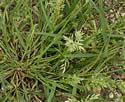 Stink Grass plants
Stink Grass plants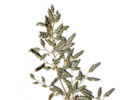 scanned plant
scanned plant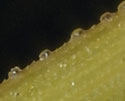 leaf hairs and glands
leaf hairs and glands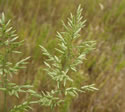 flowering plant
flowering plant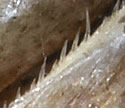 close-up of mature florets
close-up of mature florets
Photos courtesy Peter M. Dziuk taken in Anoka and Ramsey counties and in North Dakota.
Comments
Have you seen this plant in Minnesota, or have any other comments about it?
on: 2017-05-29 19:19:34
lots of larger areas of this grass are found on our farmsite. will it smother out lawn grass? will common lawn spray get rid of this?
on: 2017-05-29 20:52:13
Kim, it's an annual so any pre-emergent that you'd use on crabgrass should work on this, too.






